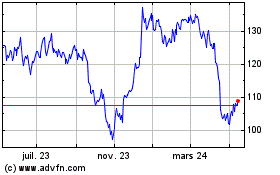Developers Woo Retail Tenants With Tallest-Ever Warehouses
22 Janvier 2019 - 3:29PM
Dow Jones News
By Esther Fung and Keiko Morris
Developers across the U.S. are racing to build larger and more
sophisticated warehouses, aiming to capitalize on retailers' desire
for ever-faster deliveries.
Property owners are competing for industrial space where
companies can sort packages closer to urban consumers and deliver
them more rapidly. To attract tenants, developers are offering a
wide range amenities, like more loading docks, higher ceilings,
hundreds of parking spaces, and stronger structures to support the
movement of large volumes of goods.
They are also building warehouses higher than ever. Less than a
year after Prologis Inc. opened the country's first three-story
warehouse in Seattle -- a 589,615 square-foot facility that has
ramps to the second-floor and a freight elevator to the third floor
-- developers in New York, North Carolina and Wisconsin are
building the first ones with four stories.
"I think when it's done, it will be an iconic building," said
Dov Hertz, president of DH Property, referring to a planned
four-story Brooklyn warehouse in Sunset Industrial Park along the
Gowanus Canal.
His firm and Bridge Development Partners LLC recently purchased
an 18-acre site where they plan to demolish existing buildings to
build a four-story, approximately 1.2 million-square-foot
distribution center.
The first two stories of the planned warehouse will have a
height of 32 feet each, and the upper two stories will be 28 feet
each, making the facility as tall as a 12-story building.
Development is expected to start by the end of 2020. DH Property is
also building a three-story warehouse in Brooklyn.
In the Bronx, Innovo Property Group is demolishing a movie
theater to make way for a ramped, two-story warehouse with 863
parking spaces -- an enormous capacity in New York City but
necessary for modern, functional facilities -- said the firm's
chief executive, Andrew Chung.
Brokers say it's a coup for developers to secure large sites in
New York, because they offer tenants faster access to households in
Brooklyn and Queens than do existing New Jersey warehouses.
But some analysts say these state-of-the-art warehouses are
risky bets. Developers are paying for expensive land, usually
without a committed tenant. Most retail tenants commit only after
they see steel going up. Multi-story warehouses are also more
costly to build, with a rule of thumb that the cost per square foot
is doubled for every floor added, real estate executives say.
There are also questions about the depth of demand and whether
these new warehouses will address the needs of tenants that may
change during the next few years.
"Is there demand for such a luxury good? That's the
billion-dollar question," said Eric Frankel, an analyst with Green
Street Advisors.
On Staten Island, warehouse developer Matrix Development Group,
which counts furniture chain IKEA and Amazon.com Inc. as tenants,
is not planning to build any multistory projects.
For us, "much less expensive spaces is the better-end of the
market," said Matrix's Chief Executive Officer Joe Taylor, adding
that suburban facilities do offer flexibility for tenants catering
to New York City.
Still, some said these higher expenses are justified. If tenants
can save on labor and transportation costs, which account for more
of the expenses in supply chains, they will be willing to pay
higher rents. Parking space for trucks is also in high demand,
especially in New York.
"There's a lot of value to fleet parking," said Brad Cohen,
senior vice president at property consultancy CBRE.
In New York City, warehouse rents averaged $20.89 per square
foot in the fourth quarter last year, up 4.5% from a year earlier,
according to data from CoStar Group. Rents in the rest of the New
York metro area rose 4.9% to $10.43 per square foot over the same
period.
"Are we slightly above market rents? Yes, but we can't be too
far out of whack," said Jeff Milanaik, partner for Bridge
Development Partners' Northeast region. He estimated that rents
could be around the mid-$30s per square foot.
Write to Esther Fung at esther.fung@wsj.com and Keiko Morris at
Keiko.Morris@wsj.com
(END) Dow Jones Newswires
January 22, 2019 09:14 ET (14:14 GMT)
Copyright (c) 2019 Dow Jones & Company, Inc.
Prologis (NYSE:PLD)
Graphique Historique de l'Action
De Mar 2024 à Avr 2024

Prologis (NYSE:PLD)
Graphique Historique de l'Action
De Avr 2023 à Avr 2024
